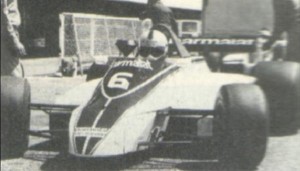A Road with Many Turns – Why There Are No Americans in F1 – Part 1
A discussion that can be kicked around for ages by American F1 fans is Why are there no Americans’ in F1. Truly, there has to be drivers in the US who are talented enough to compete at what many consider the pinnacle of motor racing. Doesn’t F1 in it’s quest to be a global brand have to have an American driver? In this multi part post, we’ll take a look at where we’ve been, why we are where we are and what would it take to get an American into F1.
A la CART?
Thanks or blame (depending on who you are) Bernie Ecclestone for making F1 into the hybrid of the highly exclusive country club/grand corporate spectacle that it is today. Gone are the days when a team could buy a competitive chassis from March or McLaren, put a Cosworth DFV in the back and select a few races to run and with a good driver, have more than a puncher’s chance of being competitive.
In addition to buying a competitive car, driver’s raced multiple series at a time. There was a point when Mark Donohue in the early 70’s was running Can-Am one weekend, USAC the next, the Trans-Am and then the occasional F1 race thrown in. With the cost of racing going up, teams began to protect their investments and have their drivers sign exclusive contracts; everyone was now stuck to one series which didn’t allow opportunities like drivers such as Revson, Donohue, Lunger and Folmer had in F1 in the 70’s.
The emergence of CART and the F1 Concorde Agreement in the early 80’s can be seen as when the fate of American drivers and teams jumping in and out of F1 began to be sealed. F1 was now an exclusive club and CART gave American’s a well paid, organized and prestigious series on their home soil. The door for American racers to F1 was offically slammed in 1980 when Rick Mears tested for Brabham (whose owner was…Bernie Ecclestone). Mears tested for Brabham twice and was fast as their world champion driver Nelson Piquet. An offer was given to Mears but Mears declined it. According to the way the story has been told, a number was in the contract that Mears (who at this point was a CART star and probably the most talented driver in America) thought he would be paid, but instead it was the amount that Bernie wanted him to bring to the team for the seat.
While the 80’s rolled on, CART began to look a bit like what F1 looked liked before Bernie, there were top teams but a team could buy a competitive chassis and engine and with right preparation and driver could be competitive. F1 became a place of the have and have nots, with only a handful of teams at the sharp end of grid. Foreign drivers began coming to CART in late 80’s/early 90 as they could be in a competitive car and get paid instead of being at the tail end of the F1 grid paying for a ride.
By the early 90’s CART was the best racing series in the world with a full competitive grid and was beginning to make a global expansion that had started with the Surfer’s Paradise race in 1991. It had stolen F1’s thunder in the US starting in 1984 when the Long Beach Grand Prix became a CART fixture, while the F1 race in American finally died out with Phoenix in 1991. Any American star was now in CART with a competitive ride and a multi million dollar retainer. The last American in F1 during this time was Eddie Cheever. An American who had grown up in Rome, Cheever was talented driver who spent his F1 career driving for mid pack teams. At the end of 1989, Cheever left F1 and joined CART running for Chip Ganassi’s team.
As the 90’s began there we no Americans in F1 as CART had all the American stars and was starting compete as a global rival to F1,
Coming Soon – Part II – The Biggest is the Smallest.



Recent Comments